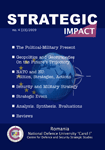POWER RELATIONS BETWEEN REALISM AND NEOREALISM IN HANS MORGENTHAU’S AND KENNETH WALTZ’S VISIONS
POWER RELATIONS BETWEEN REALISM AND NEOREALISM IN HANS MORGENTHAU’S AND KENNETH WALTZ’S VISIONS
Author(s): Niculae TabarciaSubject(s): Political Theory, International relations/trade, Security and defense, Military policy, Peace and Conflict Studies
Published by: Carol I National Defence University Publishing House
Keywords: realism; neorealism;
Summary/Abstract: The international relations, as a field of the academic research, consists of two fundamental trends– realist and liberal – that endeavor to theorize the nature of the international system of states and its modus operandi. Although the intellectual roots of the realism are often identified in Thucydides’ stories on the Peloponnesian Wars, the first classic actors of realism (Niccolo Machiavelli, Thomas Hobbes) came about a few centuries later and the first realist extensive theories on the international relations emerged in the 21st century. This essay intends to compare the approach on the concept of power used by Hans Morgenthau and Kenneth Waltz in their works which are considered as being representative – Politics among nations, The man, the state and the war, respectively and The theory of the international politics. In Politics among nations, Morgenthau made an exposé on the vision resting on the relations among states in the international stage which has dominated the study on the international politics for almost two generations, while Kenneth Waltz, through The theory of the international politics, divided the realist group into two parts – classic realist and neorealist. Nevertheless, a partition of the approach used for the power concept following a simple way which is that of trends, realist and neorealist might prove ineffective given that it could try to harmonize two groups of thinkers who manifested considerable variations as far as the levels of approach are concerned – from the adopted perspective on the level of the system or of the state-actor to the actual elements of the foreign policy. Thus, Hans Morgenthau (classic realism) and Kenneth Waltz (neo-realism) have been selected as representatives of the two thinking trends due to the influence each exerted within the trend they belong to.
Journal: Strategic Impact
- Issue Year: 2009
- Issue No: 33
- Page Range: 79-85
- Page Count: 7
- Language: English

